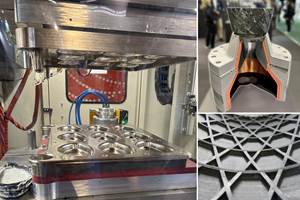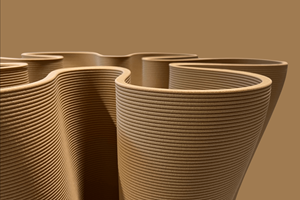Low-CO2 recycled composite reduces environmental, economic footprint
CAMX 2025: Fairmat exhibits FairPly, a scalable, versatile material engineered from cured CFRP chips that releases 90% less manufacturing emissions and can be incorporated with a variety of other virgin material systems.
Share
Source | Fairmat
FairPly, exhibited by (Paris, France) addresses the escalating global problem of carbon fiber composite waste. It is contended to be one of the lowest CO2-emitting recycled materials — up to 90% — at equivalent properties compared to virgin carbon fiber-reinforced polymer (CFRP) manufacturing, and aims to eliminate the “green premium” through significant cost reduction.
FairPly is engineered from Fairmat’s cured CFRP chips. These chips are created through a mechanical recycling process that preserves fiber integrity and length, then assembled into a thin layer of even thickness that mimics other conventional composite forms. A veil or woven fabric is generally used to support the chips, depending on the type of molding technique or application.
Fairmat leverages advanced robotics, AI, proprietary software and computer vision for high precision, quality and accuracy in manufacturing. This technology ensures batch-to-batch consistency and predictable performance.
FairPly can be made into a part by laminating multiple layers together or by combining it with other virgin materials. It supports various composite processes including resin films and liquid resin application methods like wet layup, infusion, resin transfer molding (RTM) and spraying. It can also be combined in between resin-rich prepregs as a form of hybridization. FairPly is compatible with a wide range of co-materials such as glass and carbon fibers, foams and honeycomb core. Fairmat says this versatility enables the creation of hybrid composite structures and gradual incorporation of recycled content into any part. Its storage at room temperature simplifies logistics.
Beyond standard applications, FairPly’s semi-discontinuous nature has led to additional unforeseen benefits, such as enhanced damping in skis and shoe insoles as well as improved impact perception in racket sports.
Related Content
-
JEC World 2024 highlights: Thermoplastic composites, CMC and novel processes
CW senior technical editor Ginger Gardiner discusses some of the developments and demonstrators shown at the industry’s largest composites exhibition and conference.
-
Plant tour: Teijin Carbon America Inc., Greenwood, S.C., U.S.
In 2018, Teijin broke ground on a facility that is reportedly the largest capacity carbon fiber line currently in existence. The line has been fully functional for nearly two years and has plenty of room for expansion.
-
Revisiting the OceanGate Titan disaster
A year has passed since the tragic loss of the Titan submersible that claimed the lives of five people. What lessons have been learned from the disaster?
Related Content
JEC World 2024 highlights: Thermoplastic composites, CMC and novel processes
CW senior technical editor Ginger Gardiner discusses some of the developments and demonstrators shown at the industry’s largest composites exhibition and conference.
Read MorePlant tour: Teijin Carbon America Inc., Greenwood, S.C., U.S.
In 2018, Teijin broke ground on a facility that is reportedly the largest capacity carbon fiber line currently in existence. The line has been fully functional for nearly two years and has plenty of room for expansion.
Read MoreRevisiting the OceanGate Titan disaster
A year has passed since the tragic loss of the Titan submersible that claimed the lives of five people. What lessons have been learned from the disaster?
Read MoreSulapac introduces Sulapac Flow 1.7 to replace PLA, ABS and PP in FDM, FGF
Available as filament and granules for extrusion, new wood composite matches properties yet is compostable, eliminates microplastics and reduces carbon footprint.
Read MoreRead Next
Fairmat and the rise of deep tech in France
This first column in CW’s new Investors and Startups column series takes a closer look into the region of France, decoding the technologies, teams and funding actors driving its composites innovation.
Read MoreCutting 100 pounds, certification time for the X-59 nose cone
Swift Engineering used HyperX software to remove 100 pounds from 38-foot graphite/epoxy cored nose cone for X-59 supersonic aircraft.
Read MoreScaling up, optimizing the flax fiber composite camper
Greenlander’s Sherpa RV cab, which is largely constructed from flax fiber/bio-epoxy sandwich panels, nears commercial production readiness and next-generation scale-up.
Read More






